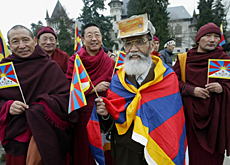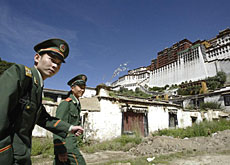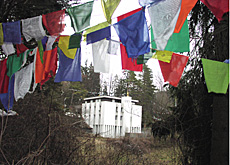From the Himalayas to the Swiss mountains

Having fled their native land following the Chinese occupation 50 years ago, many Tibetans have found a second home in Switzerland.
The Swiss authorities have welcomed more Tibetan refugees than any other European country.
“Tibetans have integrated very well and people generally speak well of them,” says Lobsang Gangshothang, president of the Tibetan community in Switzerland.
There are about 3,500 Tibetans in Switzerland, making it the third largest Tibetan community in the world, after those who remained in the India/Nepal region and the Tibetan diaspora in the United States.
Open doors
“Most of us arrived here more than 40 years ago,” explains Jampa Tsering, former national president of the community. “In the early 1960s, the Red Cross helped many fugitives to leave their refugee camps in India and obtain refugee status in Switzerland.”
After the upheavals of 1959 – the year of the first popular rebellion against the Chinese occupation and the exile of the 14th Dalai Lama to India – the Swiss government decided to open the door to 1,000 refugees.
Many orphans were also able to leave the difficult conditions of the refugee camps at Dharamsala, in the north of India, following an agreement between the Dalai Lama – the spiritual leader of the Tibetan people – and a medical doctor in Switzerland.
As a result, some 300 children were adopted or entrusted to the charity, Pestalozzi Children’s Foundation.
Swiss and Tibetan
After working in textile factories and industry during the early decades of their life as immigrants, today Tibetans are active in various sectors of the Swiss economy. It is not uncommon to come across them in a school classroom or behind the counter in a bank.
“Many have now been granted Swiss citizenship,” says Jampa Tsering. Nevertheless, their links with Tibetan culture and traditions remain strong, especially among first-generation immigrants.
“The community funds Tibetan schools throughout Switzerland and organises reunions and traditional festivities,” he added.
The aim is to preserve a language and culture which in Tibet are threatened with extinction because of the “suffocating” Chinese presence, Jampa explains.
Rikon monastery
The focal point of the spiritual and cultural life of Tibetans in Switzerland is the monastery of Rikon, 30km outside Zurich.
It was founded in 1967, a result of joint efforts by the Dalai Lama and the brothers Henri and Jacques Kuhn, whose engineering firm was one of the first to employ Tibetan refugees. For more than 30 years, Rikon monastery has housed the Institute of Tibetan Studies.
The white concrete building on the hill overlooking the small town is home to about ten Tibetan monks.
As well as performing religious rites, they teach the art of meditation and the Tibetan language.
“We receive between ten and 30 people a week. Most of them are Tibetans, but there is no lack of interest among native Swiss people,” says Tokhang Khedup, who has been at Rikon since 1969.
Dalai Lama and Switzerland
The Dalai Lama is currently on a visit to Switzerland and is holding a series of teachings on the theme of “Overcoming disturbing emotions” at the Hallenstadion in Zurich.
“It is an opportunity for us to hear his teachings, together with Swiss friends and people from all over the world,” says Tashi Albertini. “We are particularly pleased that he is here for his 70th birthday.”
According to the president of the Ticino-Tibet Association, the generosity shown by the Swiss authorities in welcoming Tibetan refugees has created a very special bond between the Dalai Lama and Switzerland.
As if to confirm this affinity, in one of his autobiographical writings the Dalai Lama noted “the Swiss mountains remind me of those of Tibet”.
swissinfo, Luigi Jorio
Switzerland is home to 3,500 Tibetans.
They form the biggest Tibetan community in Europe, and the third largest in the world.
From August 5-12, the Dalai Lama will be at the Hallenstadion in Zurich to speak publicly on Tibetan spirituality.
Tibet, surrounded by China, Myanmar and India, has a surface area of 1,200,000 square kilometres (cf. Switzerland: 41,000).
It has a population of 2.5 million. In 1950 the Chinese army, led by Mao Zedong, occupied the Himalayan region.
In 1959, Chinese security forces put down a popular uprising and the 14th Dalai Lama was forced into exile in India. There he set up a Tibetan government at Dharamsala.
An estimated 150,000 Tibetans have sought refuge abroad.

In compliance with the JTI standards
More: SWI swissinfo.ch certified by the Journalism Trust Initiative



You can find an overview of ongoing debates with our journalists here. Please join us!
If you want to start a conversation about a topic raised in this article or want to report factual errors, email us at english@swissinfo.ch.